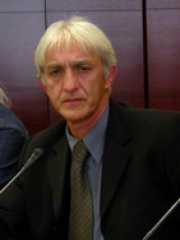
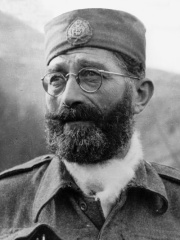
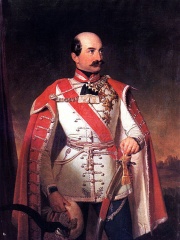
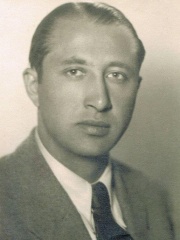
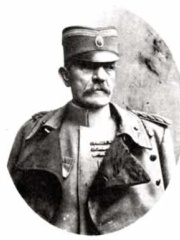
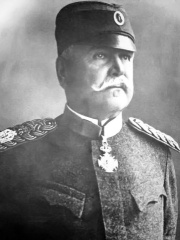
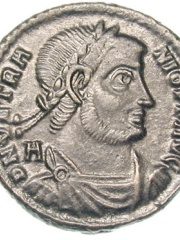

The Most Famous
MILITARY PERSONNELS from Serbia
This page contains a list of the greatest Serbian Military Personnels. The pantheon dataset contains 2,058 Military Personnels, 12 of which were born in Serbia. This makes Serbia the birth place of the 21st most number of Military Personnels behind Czechia, and Finland.
Top 10
The following people are considered by Pantheon to be the top 10 most legendary Serbian Military Personnels of all time. This list of famous Serbian Military Personnels is sorted by HPI (Historical Popularity Index), a metric that aggregates information on a biography's online popularity. Visit the rankings page to view the entire list of Serbian Military Personnels.

1. Romulus Augustulus (460 - 527)
With an HPI of 81.58, Romulus Augustulus is the most famous Serbian Military Personnel. His biography has been translated into 81 different languages on wikipedia.
Romulus Augustus (c. 460-465) – (c. 511-530), nicknamed Augustulus, was Roman emperor of the West from 31 October 475 until 4 September 476. Romulus was placed on the imperial throne while still a minor by his father Orestes, the magister militum, for whom he served as little more than a figurehead. After a rule of ten months, the barbarian general Odoacer defeated and killed Orestes and deposed Romulus. As Odoacer did not proclaim any successor, Romulus is typically regarded as the last Western Roman emperor, his deposition marking the end of the Western Roman Empire as a political entity. The deposition of Romulus Augustulus is also sometimes used by historians to mark the transition from antiquity to the medieval period. Very few records survive of Romulus's reign. There are no known policies, laws or inscriptions of significance of the emperor, which leaves the impression that he was a shadowy and relatively inconsequential figure. The nickname "Augustulus" means "little Augustus" and was a derisive reference to his young age. Romulus's immediate family, including his father and possibly his mother, and maybe both his paternal and maternal grandparents, were from the Roman province of Pannonia, and many of his family members had military backgrounds. Romulus came to power through the usurpation of his predecessor Julius Nepos (r. 474–475 in Italy) in 475. Nepos fled to Dalmatia and continued to claim the imperial title in exile, which hampered Romulus's legitimacy and ensured that he was never recognised by the Eastern Roman emperor Zeno. In 476, the allied barbarian foederati in Italy demanded Italian lands to settle on, which was refused by Orestes. Under Odoacer, the foederati defeated and killed Orestes and deposed Romulus, whereafter Odoacer became the first King of Italy and accepted Emperor Zeno as his nominal superior. Romulus's life was spared by Odoacer, and he was allowed to retire to the castellum Lucullanum, a great fortress in Campania. Little certain information is known concerning Romulus's life in exile. He might have played a role in founding a monastery at castellum Lucullanum in the 480s or 490s, dedicated to Saint Severinus of Noricum. Romulus could have been alive as late as 507 or 511 when Theodoric the Great, Odoacer's successor, wrote a letter to a "Romulus" concerning a pension, but was likely dead before his mid-40s, as accounts of the eastern Roman invasion of Italy at that time do not mention him.

2. Draža Mihailović (1893 - 1946)
With an HPI of 73.17, Draža Mihailović is the 2nd most famous Serbian Military Personnel. His biography has been translated into 36 different languages.
Dragoljub "Draža" Mihailović (Serbian Cyrillic: Драгољуб "Дража" Михаиловић; 27 April 1893 – 17 July 1946) was a Yugoslav Serb general during World War II. He was the leader of the Chetnik Detachments of the Yugoslav Army (Chetniks), a royalist and nationalist movement and guerrilla force established following the German invasion of Yugoslavia in 1941. Born in Ivanjica and raised in Belgrade, Mihailović fought in the Balkan Wars and the First World War with distinction. After the fall of Yugoslavia in April 1941, Mihailović organized the Chetniks at Ravna Gora and engaged in guerrilla warfare alongside Josip Broz Tito's Partisans against occupying German forces. Opposing strategies, ideological differences and general distrust drove them apart, and by late 1941 the two groups were in open conflict. Many Chetnik groups collaborated or established modus vivendi with the Axis powers, which along with British frustration over Mihailović's inaction led to the Allies shifting their support to Tito in 1944. Mihailović himself collaborated with fascist collaborators Milan Nedić and Dimitrije Ljotić at the end of the war. Mihailović went into hiding after the war but was captured in March 1946. He was tried and convicted of high treason and war crimes by the communist authorities of the Federal People's Republic of Yugoslavia, and executed by firing squad in Belgrade in July. The nature and extent of his responsibility for collaboration and ethnic massacres remains controversial. In May 2015, Mihailović's verdict was overturned on appeal by the Supreme Court of Cassation of Serbia, citing his trial and conviction as politically and ideologically motivated.

3. Josip Jelačić (1801 - 1859)
With an HPI of 71.89, Josip Jelačić is the 3rd most famous Serbian Military Personnel. His biography has been translated into 37 different languages.
Count Josip Jelačić von Bužim (16 October 1801 – 20 May 1859; also spelled Jellachich, Jellačić or Jellasics; Croatian: Josip grof Jelačić Bužimski; Hungarian: Jelasics József) was a Croatian lieutenant field marshal in the Imperial Austrian Army and politician. He was the Ban of Croatia between 23 March 1848 and 19 April 1859. He was a member of the House of Jelačić and a noted army general, remembered for his military campaigns during the Revolutions of 1848 and for his abolition of serfdom in Croatia.

4. Duško Popov (1912 - 1981)
With an HPI of 68.97, Duško Popov is the 4th most famous Serbian Military Personnel. His biography has been translated into 22 different languages.
Dušan "Duško" Popov (Serbian Cyrillic: Душко Попов; 10 July 1912 – 10 August 1981) was a Serbian intelligence agent, lawyer and businessman who served as a double agent for MI6 during World War II. Feigning to be an asset of the German Abwehr, he passed off disinformation to Germany as part of the British Double-Cross System while occasionally using cover as a diplomat for the Yugoslav government-in-exile in London. Popov was born into a wealthy family and was practicing law at the start of the war. He held a great aversion to Nazism, and in 1940, infiltrated the Abwehr, Germany's military intelligence service, which considered him a valuable asset due to his business connections in France and the United Kingdom. Popov provided the Germans with misleading and inaccurate information for much of the war. Deceptions in which he participated included Operation Fortitude, which sought to convince German military planners that the Allied invasion of Europe would take place in Calais, not Normandy, thereby diverting hundreds of thousands of German troops and increasing the likelihood that Operation Overlord would succeed. Popov was known for his lifestyle and courted women during his missions, including the French actress Simone Simon. Apart from MI6 and the Abwehr, he also reported to the Yugoslav intelligence service, which assigned him the codename Duško. His German handlers referred to him by the codename Ivan. He was codenamed Tricycle by the British MI5 because he was the head of a group of three double agents. In 1974, he published an autobiography titled Spy/Counterspy, in which he recounted his wartime exploits. Popov is considered one of Ian Fleming's primary inspirations for the character of James Bond. He has been the subject of a number of non-fiction books and documentaries.
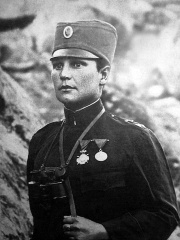
5. Milunka Savić (1890 - 1973)
With an HPI of 65.89, Milunka Savić is the 5th most famous Serbian Military Personnel. Her biography has been translated into 31 different languages.
Milunka Savić CMG (Serbian Cyrillic: Милунка Савић; 28 June 1892 – 5 October 1973) was a Serbian war heroine who fought in the Balkan Wars and in World War I. She is the most-decorated female combatant in the history of human warfare. She was wounded in battle nine times, and because of her immense courage and leadership, the French called her the "Serbian Joan of Arc".

6. Živojin Mišić (1855 - 1921)
With an HPI of 65.46, Živojin Mišić is the 6th most famous Serbian Military Personnel. His biography has been translated into 27 different languages.
Živojin Mišić (Serbian Cyrillic: Живојин Мишић; 19 July 1855 – 20 January 1921) was a field marshal who participated in all of Serbia's wars from 1876 to 1918. He directly commanded the First Serbian army in the Battle of Kolubara and in breach of the Thessaloniki Front was the Chief of the Supreme Command. He is the most decorated Serbian military officer in history.

7. Stepa Stepanović (1856 - 1929)
With an HPI of 64.42, Stepa Stepanović is the 7th most famous Serbian Military Personnel. His biography has been translated into 26 different languages.
Stepan "Stepa" Stepanović (Serbian Cyrillic: Степан Степа Степановић, pronounced [stɛ̌ːpa stɛpǎːnoʋitɕ]; 11 March [O.S. 28 February] 1856 – 29 April 1929) was a Serbian military commander who fought in the Serbo-Turkish War, the Serbo-Bulgarian War, the First Balkan War, the Second Balkan War and World War I. Having joined the Serbian military in 1874, he fought against the forces of the Ottoman Empire in 1876. Over the following years, he climbed up the ranks of the Serbian Army and fought against Bulgarian forces in 1885. He eventually became the Serbian Minister of War in April 1908 and was responsible for instituting changes in the Serbian Army. Stepanović commanded Serbian forces during the two Balkan Wars and led the Serbian Second Army during World War I. After Battle of Cer he was promoted to second Field Marshal. He died in Čačak on 29 April 1929.

8. Vetranio (300 - 356)
With an HPI of 62.11, Vetranio is the 8th most famous Serbian Military Personnel. His biography has been translated into 39 different languages.
Vetranio (died c. 356 AD) was briefly an imperial usurper and emperor in the Roman Empire in 350, during which time he controlled Illyricum between the rival emperors Magnus Magnentius and Constantius II, eventually capitulating to the latter.

9. Petar Bojović (1858 - 1945)
With an HPI of 61.58, Petar Bojović is the 9th most famous Serbian Military Personnel. His biography has been translated into 20 different languages.
Petar Bojović (Serbian: Петар Бојовић, pronounced [pětar bǒːjoʋitɕ]; 16 July 1858 – 19 January 1945) was a Serbian and Yugoslav military commander who fought in the Serbo-Turkish War, the Serbo-Bulgarian War, the First Balkan War, the Second Balkan War, and World War I. He was briefly the Deputy Commander-in-Chief of the Yugoslav Royal Army in World War II, but played no real part in the conduct of the defence of Yugoslavia when it was invaded by the Axis powers in April 1941. Following the breakthrough on the Thessaloniki Front of World War I, he became the fourth Serbian officer promoted to field marshal.
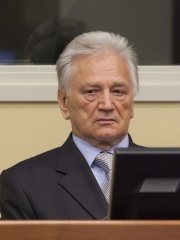
10. Momčilo Perišić (b. 1944)
With an HPI of 58.90, Momčilo Perišić is the 10th most famous Serbian Military Personnel. His biography has been translated into 16 different languages.
Momčilo Perišić (Serbian Cyrillic: Момчило Перишић; born 22 May 1944) is a Serbian former general and politician who served as the Chief of the General Staff of the Armed Forces of Yugoslavia between 1993 and 1998. On 6 September 2011, in a first-instance verdict, Perišić was found guilty of war crimes and crimes against humanity for his role in the Yugoslav Wars and sentenced to 27 years of imprisonment. On 28 February 2013, the Appeals Chamber reversed this decision and acquitted him on all counts. In 2021, the Belgrade Higher Court sentenced Perišić to three years' imprisonment for passing state secrets to the United States in 2002. On appeal, his sentence was increased to four years imprisonment.
People
Pantheon has 12 people classified as Serbian military personnels born between 300 and 1954. Of these 12, 3 (25.00%) of them are still alive today. The most famous living Serbian military personnels include Momčilo Perišić, Sefer Halilović, and Dragan Vasiljković. The most famous deceased Serbian military personnels include Romulus Augustulus, Draža Mihailović, and Josip Jelačić.
Living Serbian Military Personnels
Go to all RankingsMomčilo Perišić
1944 - Present
HPI: 58.90
Sefer Halilović
1952 - Present
HPI: 57.48
Dragan Vasiljković
1954 - Present
HPI: 56.73
Deceased Serbian Military Personnels
Go to all RankingsRomulus Augustulus
460 - 527
HPI: 81.58
Draža Mihailović
1893 - 1946
HPI: 73.17
Josip Jelačić
1801 - 1859
HPI: 71.89
Duško Popov
1912 - 1981
HPI: 68.97
Milunka Savić
1890 - 1973
HPI: 65.89
Živojin Mišić
1855 - 1921
HPI: 65.46
Stepa Stepanović
1856 - 1929
HPI: 64.42
Vetranio
300 - 356
HPI: 62.11
Petar Bojović
1858 - 1945
HPI: 61.58
Overlapping Lives
Which Military Personnels were alive at the same time? This visualization shows the lifespans of the 7 most globally memorable Military Personnels since 1700.


